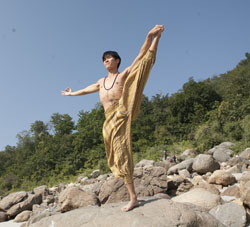It would make sense to be hugely grateful for happiness. Filled with a true deep happiness, how could one be anything other than grateful? That said, I believe it’s huge gratitude that engenders happiness in the first place. To me, intentional gratitude is the seed and the soil and the sun and the rain. And happiness is what sprouts organically from that.
“Happiness cannot be traveled to, owned, earned, worn or consumed. Happiness is the spiritual experience of living every minute with love, grace and gratitude.” Denis Waitley
It’s my Yoga practice that showed me that the Gratitude State is both a choice and a cosmic wormhole to joy. And for that teaching, I’m so ridiculously grateful! It’s a delicious, recursive loop.
“Gratefulness is the key to a happy life that we hold in our hands, because if we are not grateful, then no matter how much we have we will not be happy… “ — Brother David Steindl-Rast
Gratitude is specific. We are ‘grateful for’ or ‘grateful to’. So let me be specific. I’m grateful for the gift of joy that the Yoga teachings has delivered to me. I’m grateful to my Yoga teachers, and to their teachers, and theirs - all the way back in time. I try to picture this ancient, teaching lineage right back to its roots. It’s like contemplating the infinity of deep space; marvelous and totally unfathomable.
“If you concentrate on finding whatever is good in every situation, you will discover that your life will suddenly be filled with gratitude, a feeling that nurtures the soul.” — Rabbi Harold Kushner
It is said that it’s a great blessing to encounter the Yoga teachings in one’s lifetime. And clearly I agree. Moreover I’m twice-blessed. I get to share these amazing teachings as my full time occupation. Sometimes, seriously, I just have to side hop and click my heels with delight.
“Both abundance and lack exist simultaneously in our lives, as parallel realities. It is always our conscious choice which secret garden we will tend… when we choose not to focus on what is missing from our lives but are grateful for the abundance that’s present — love, health, family, friends, work, the joys of nature and personal pursuits that bring us pleasure — the wasteland of illusion falls away and we experience Heaven on earth.” –Sarah Ban Breathnach
And so, from time to time, needing to take action on my gratitude for Yoga, I have trees planted in the names of my teachers and my teacher's teachers and my students -and very importantly! - also in the names of the studios and the people who run those studios that make it possible for me to teach.
“If the only prayer you say in your life is thank you, that would suffice.” — Meister Eckhart
Recently, I arranged for 40 trees to be planted. They'll be planted in parts of the world that suffer from deforestation and they'll be fruit bearing trees which will get planted in areas that suffer from lack of food (my guess is they'll be planted in Haiti, but the organization that does the planting – www.treesforlife.org - will decide where it's needed most). So that's to say, some beautiful life-giving trees will go into the ground in the name of New York Yoga and my students here, in gratitude for enabling me to share the gift of Yoga.
And let me be clear, it’s a totally selfish act on my part. Because doing so brings me so much joy.
“Two kinds of gratitude: The sudden kind we feel for what we take; the larger kind we feel for what we give.” — Edwin Arlington Robinson




